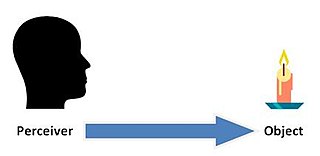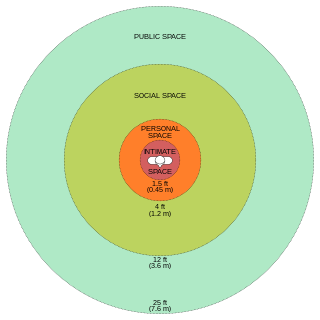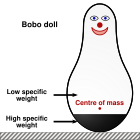
Psychometrics is a field of study within psychology concerned with the theory and technique of measurement. Psychometrics generally refers to specialized fields within psychology and education devoted to testing, measurement, assessment, and related activities. Psychometrics is concerned with the objective measurement of latent constructs that cannot be directly observed. Examples of latent constructs include intelligence, introversion, mental disorders, and educational achievement. The levels of individuals on nonobservable latent variables are inferred through mathematical modeling based on what is observed from individuals' responses to items on tests and scales.
An operational definition specifies concrete, replicable procedures designed to represent a construct. In the words of American psychologist S.S. Stevens (1935), "An operation is the performance which we execute in order to make known a concept." For example, an operational definition of "fear" often includes measurable physiologic responses that occur in response to a perceived threat. Thus, "fear" might be operationally defined as specified changes in heart rate, galvanic skin response, pupil dilation, and blood pressure.
Solipsism is the philosophical idea that only one's mind is sure to exist. As an epistemological position, solipsism holds that knowledge of anything outside one's own mind is unsure; the external world and other minds cannot be known and might not exist outside the mind.
Validity is the main extent to which a concept, conclusion or measurement is well-founded and likely corresponds accurately to the real world. The word "valid" is derived from the Latin validus, meaning strong. The validity of a measurement tool is the degree to which the tool measures what it claims to measure. Validity is based on the strength of a collection of different types of evidence described in greater detail below.
An unobservable is an entity whose existence, nature, properties, qualities or relations are not directly observable by humans. In philosophy of science, typical examples of "unobservables" are the force of gravity, causation and beliefs or desires. The distinction between observable and unobservable plays a central role in Immanuel Kant's distinction between noumena and phenomena as well as in John Locke's distinction between primary and secondary qualities. The theory that unobservables posited by scientific theories exist is referred to as scientific realism. It contrasts with instrumentalism, which asserts that we should withhold ontological commitments to unobservables even though it is useful for scientific theories to refer to them. There is considerable disagreement about which objects should be classified as unobservable, for example, whether bacteria studied using microscopes or positrons studied using cloud chambers count as unobservable. Different notions of unobservability have been formulated corresponding to different types of obstacles to their observation.

Experimental psychology refers to work done by those who apply experimental methods to psychological study and the underlying processes. Experimental psychologists employ human participants and animal subjects to study a great many topics, including sensation & perception, memory, cognition, learning, motivation, emotion; developmental processes, social psychology, and the neural substrates of all of these.

In the philosophy of perception and philosophy of mind, direct or naïve realism, as opposed to indirect or representational realism, are differing models that describe the nature of conscious experiences; out of the metaphysical question of whether the world we see around us is the real world itself or merely an internal perceptual copy of that world generated by our conscious experience.

In research design, especially in psychology, social sciences, life sciences and physics, operationalization or operationalisation is a process of defining the measurement of a phenomenon which is not directly measurable, though its existence is inferred from other phenomena. Operationalization thus defines a fuzzy concept so as to make it clearly distinguishable, measurable, and understandable by empirical observation. In a broader sense, it defines the extension of a concept—describing what is and is not an instance of that concept. For example, in medicine, the phenomenon of health might be operationalized by one or more indicators like body mass index or tobacco smoking. As another example, in visual processing the presence of a certain object in the environment could be inferred by measuring specific features of the light it reflects. In these examples, the phenomena are difficult to directly observe and measure because they are general/abstract or they are latent. Operationalization helps infer the existence, and some elements of the extension, of the phenomena of interest by means of some observable and measurable effects they have.
Construct validity concerns how well a set of indicators represent or reflect a concept that is not directly measurable. Construct validation is the accumulation of evidence to support the interpretation of what a measure reflects. Modern validity theory defines construct validity as the overarching concern of validity research, subsuming all other types of validity evidence such as content validity and criterion validity.
In psychometrics, predictive validity is the extent to which a score on a scale or test predicts scores on some criterion measure.
A theoretical definition defines a term in an academic discipline, functioning as a proposal to see a phenomenon in a certain way. A theoretical definition is a proposed way of thinking about potentially related events. Theoretical definitions contain built-in theories; they cannot be simply reduced to describing a set of observations. The definition may contain implicit inductions and deductive consequences that are part of the theory. A theoretical definition of a term can change, over time, based on the methods in the field that created it.
A referent is a person or thing to which a name – a linguistic expression or other symbol – refers. For example, in the sentence Mary saw me, the referent of the word Mary is the particular person called Mary who is being spoken of, while the referent of the word me is the person uttering the sentence.
In psychometrics, criterion validity, or criterion-related validity, is the extent to which an operationalization of a construct, such as a test, relates to, or predicts, a theoretical representation of the construct—the criterion. Criterion validity is often divided into concurrent and predictive validity based on the timing of measurement for the "predictor" and outcome. Concurrent validity refers to a comparison between the measure in question and an outcome assessed at the same time. Standards for Educational & Psychological Tests states, "concurrent validity reflects only the status quo at a particular time." Predictive validity, on the other hand, compares the measure in question with an outcome assessed at a later time. Although concurrent and predictive validity are similar, it is cautioned to keep the terms and findings separated. "Concurrent validity should not be used as a substitute for predictive validity without an appropriate supporting rationale." Criterion validity is typically assessed by comparison with a gold standard test.
A nomological network is a representation of the concepts (constructs) of interest in a study, their observable manifestations, and the interrelationships between these. The term "nomological" derives from the Greek, meaning "lawful", or in philosophy of science terms, "law-like". It was Cronbach and Meehl's view of construct validity that in order to provide evidence that a measure has construct validity, a nomological network must be developed for its measure.
Constructive realism is a branch of philosophy, specifically the philosophy of science. It was developed in the late 1950s by Jane Loevinger and elaborated in the 1980s by Friedrich Wallner in Vienna. In his paper abstract on constructive realism, Wallner describes it as follows:
In statistics, latent variables are variables that can only be inferred indirectly through a mathematical model from other observable variables that can be directly observed or measured. Such latent variable models are used in many disciplines, including political science, demography, engineering, medicine, ecology, physics, machine learning/artificial intelligence, bioinformatics, chemometrics, natural language processing, management and the social sciences.

Paul Everett Meehl was an American clinical psychologist, Hathaway and Regents' Professor of Psychology at the University of Minnesota, and past president of the American Psychological Association. A Review of General Psychology survey, published in 2002, ranked Meehl as the 74th most cited psychologist of the 20th century, in a tie with Eleanor J. Gibson. Throughout his nearly 60-year career, Meehl made seminal contributions to psychology, including empirical studies and theoretical accounts of construct validity, schizophrenia etiology, psychological assessment, behavioral prediction, and philosophy of science.
Lee Joseph Cronbach was an American educational psychologist who made contributions to psychological testing and measurement. At the University of Illinois, Urbana, Cronbach produced many of his works: the "Alpha" paper, as well as an essay titled The Two Disciplines of Scientific Psychology, in the American Psychologist magazine in 1957, where he discussed his thoughts on the increasing divergence between the fields of experimental psychology and correlational psychology.
Reification is a fallacy of ambiguity, when an abstraction is treated as if it were a concrete real event or physical entity. In other words, it is the error of treating something that is not concrete, such as an idea, as a concrete thing. A common case of reification is the confusion of a model with reality: "the map is not the territory". A potential consequence of reification is exemplified by Goodhart's law, where changes in the measurement of a phenomenon are mistaken for changes to the phenomenon itself.
Test validity is the extent to which a test accurately measures what it is supposed to measure. In the fields of psychological testing and educational testing, "validity refers to the degree to which evidence and theory support the interpretations of test scores entailed by proposed uses of tests". Although classical models divided the concept into various "validities", the currently dominant view is that validity is a single unitary construct.





